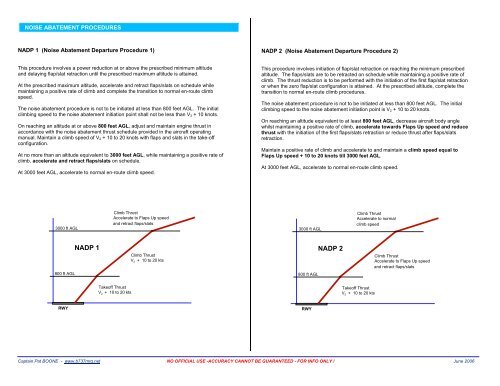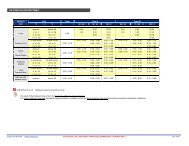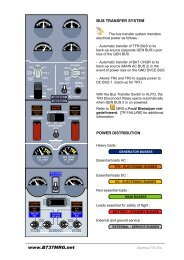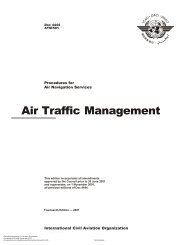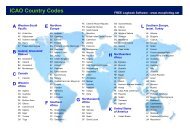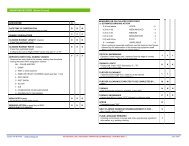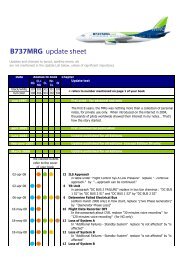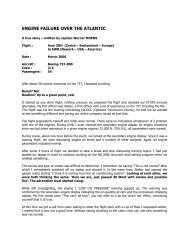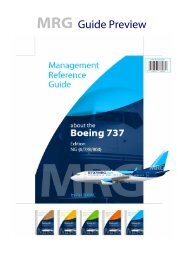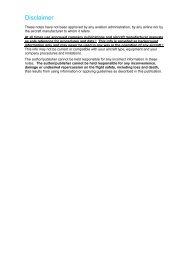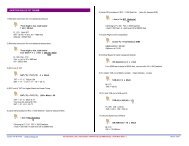Noise Abatement Procedures
Noise Abatement Procedures
Noise Abatement Procedures
- No tags were found...
You also want an ePaper? Increase the reach of your titles
YUMPU automatically turns print PDFs into web optimized ePapers that Google loves.
NOISE ABATEMENT PROCEDURESNADP 1 (<strong>Noise</strong> <strong>Abatement</strong> Departure Procedure 1)NADP 2 (<strong>Noise</strong> <strong>Abatement</strong> Departure Procedure 2)This procedure involves a power reduction at or above the prescribed minimum altitudeand delaying flap/slat retraction until the prescribed maximum altitude is attained.At the prescribed maximum altitude, accelerate and retract flaps/slats on schedule whilemaintaining a positive rate of climb and complete the transition to normal en-route climbspeed.The noise abatement procedure is not to be initiated at less than 800 feet AGL. The initialclimbing speed to the noise abatement initiation point shall not be less than V 2 + 10 knots.On reaching an altitude at or above 800 feet AGL, adjust and maintain engine thrust inaccordance with the noise abatement thrust schedule provided in the aircraft operatingmanual. Maintain a climb speed of V 2 + 10 to 20 knots with flaps and slats in the take-offconfiguration.At no more than an altitude equivalent to 3000 feet AGL, while maintaining a positive rate ofclimb, accelerate and retract flaps/slats on schedule.At 3000 feet AGL, accelerate to normal en-route climb speed.This procedure involves initiation of flap/slat retraction on reaching the minimum prescribedaltitude. The flaps/slats are to be retracted on schedule while maintaining a positive rate ofclimb. The thrust reduction is to be performed with the initiation of the first flap/slat retractionor when the zero flap/slat configuration is attained. At the prescribed altitude, complete thetransition to normal en-route climb procedures.The noise abatement procedure is not to be initiated at less than 800 feet AGL. The initialclimbing speed to the noise abatement initiation point is V 2 + 10 to 20 knots.On reaching an altitude equivalent to at least 800 feet AGL, decrease aircraft body anglewhilst maintaining a positive rate of climb, accelerate towards Flaps Up speed and reducethrust with the initiation of the first flaps/slats retraction or reduce thrust after flaps/slatsretraction.Maintain a positive rate of climb and accelerate to and maintain a climb speed equal toFlaps Up speed + 10 to 20 knots till 3000 feet AGL.At 3000 feet AGL, accelerate to normal en-route climb speed.3000 ft AGLClimb ThrustAccelerate to Flaps Up speedand retract flaps/slats3000 ft AGLClimb ThrustAccelerate to normalclimb speed800 ft AGLNADP 1Climb ThrustV + 10 to 20 kts2800 ft AGLNADP 2Climb ThrustAccelerate to Flaps Up speedand retract flaps/slatsTakeoff ThrustV + 10 to 20 kts2Takeoff ThrustV + 10 to 20 kts2RWYRWYCaptain Pat BOONE - www.b737mrg.net NO OFFICIAL USE -ACCURACY CANNOT BE GUARANTEED - FOR INFO ONLY !June 2006
PROC A (Former ICAO noise abatement Procedure A)PROC B (Former ICAO noise abatement Procedure B)From runway to 1500 feet AGL :- take-off power- take-off flaps- climb at V 2 + 10 to 20 knots(or as limited by body angle)From runway to 1000 feet AGL :- take-off power- take-off flaps- climb at V 2 + 10 to 20 knots(or as limited by body angle)At 1500 feet AGL : - reduce to climb thrust- climb at V 2 + 10 to 20 knots(or as limited by body angle)At 3000 feet AGL : - accelerate to Flaps Up speed- retract flaps/slats on schedule- accelerate smoothly to en-route climb speedAt 1000 feet AGL : - accelerate to Flaps Up speed- retract flaps/slats on scheduleWhen flaps are up : - maintain Flaps Up speed + 10 knots maximum- reduce to climb thrust (*)(*) for low bypass ratio engines,reduce thrust to below normalclimb thrust but not less thanthat necessary to maintain thefinal take-off engine-out climbgradientAt 3000 feet AGL : - accelerate smoothly to en-route climb speed3000 ft AGLClimb ThrustAccelerate to Flaps Up speedand retract flaps/slats3000 ft AGLAccelerate to normalclimb speed1500 ft AGLPROC AClimb ThrustV + 10 to 20 kts2flaps up1000 ft AGLPROC BClimb ThrustFlaps Up speed + 10 ktsAccelerate to Flaps Up speedand retract flaps/slatsTakeoff ThrustV + 10 to 20 kts2Takeoff ThrustV + 10 to 20 kts2RWYRWYCaptain Pat BOONE - www.b737mrg.net NO OFFICIAL USE -ACCURACY CANNOT BE GUARANTEED - FOR INFO ONLY !June 2006
FREE Pilot logbook softwareThe free Pilot Logbook Software offers the following features :• flights and simulator session logging• print your logbook on self-adhesive labels in different formats• automatic calculation of sunrise, sunset and night flight time• automatic interface with your airline duty roster• printing of many listings, reports, charts• export of all data to printer, to Microsoft Excel or to Acrobat PDFAdditional information :The software comes with a worldwide database with 13,000 airports, includingICAO and IATA identifiers and geographical co-ordinates. The softwareautomatically calculates sunrise, sunset and night flight time.Automatic fill-out of the return- or triangular flight leg, automatic recognitionof flight numbers.Contains pilots database to keep track of all phone numbers and e-mailaddresses, and you can even make a web cam picture of your fellow pilot.Prints your flights in different formats, such as the Professional Pilot ASAlogbook, Jeppesen Logbook, JAA-FAA-CAA Logbook, etc. If your logbookformat is not included, contact the author to have it added !Interface with you airline digital flight report or duty roster (AIMS,CrewDock, 2Log, …) and have all flights imported automatically !FREE Download :www.mccpilotlog.netCaptain Pat BOONE - www.b737mrg.net NO OFFICIAL USE -ACCURACY CANNOT BE GUARANTEED - FOR INFO ONLY !June 2006


